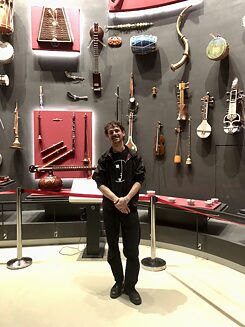 © Julius Gabriel
© Julius Gabriel
In mid-October I fnally arrived in Bangalore with my saxophones. The residency project had been postponed for me by two years due to the pandemic, but this had given me some time to prepare artistically. My local partner was the
Indian Music Experience (IME), India's only interactive music museum. Their vision is to promote the understanding and appreciation of the diversity of Indian music.
The first phase was marked by a lot of organisation, a bad stomach upset, and the ambition to jump right in musically. I first explored the museum, where I could wander through the music history of India and practice daily in their Learning Center. Lakshmi, the coordinator from the museum, assisted me on a daily basis with my schedule.
Soon afer my arrival I met my friend Arun N, on whose label Subcontinental Records I had already released a CD in 2020. He ofered to host me for a week as my accommodation was still unresolved. We went to an abandoned quarry in Bannerghatta National Park to make field recordings. Soon after, I played a solo gig at
Walkin Studios at an event called Noise Drips, and an improv session with
Yashas Shetty.
 © Julius Gabriel
© Julius Gabriel
Due to an apparent lack of urban instrument makers, I decided to abandon my idea of rebuilding a small antique diatonic saxophone. I soon attended a wonderful concert at Chowdiah Memorial Hall "Weaving Voices" featuring four prominent singers and four instrumentalists from the various streams of Indian classical music. I navigated the city with the help of local auto rickshaws. The days were long, exciting and exhausting. The nights were rather short. I must admit that the unfamiliar noise of the traffic and construction sites nearby made it difficult for me to sleep well in the first month.
 © Julius Gabriel
© Julius Gabriel
My priority as a saxophonist was to take lessons, practice, exchange ideas, rehearse and perform with other musicians 6 weeks later. The first session was with Tavil Raja, a pioneer of Carnatic jazz fusion music. I then met a prominent ghatam player Giridhar Udupa. The sessions were super fun and they introduced me to the rhythmic complexity of Carnatic music. Udupa engaged me with for a gig and through his offer, I even had a prospective artist's accommodation. He also organised a meeting with Vidwan Dakshinamurthy, a nadaswaram player par excellence, who would become my guru. I spent many hours with Dakshinamurthy and we even played together at a temple one morning. The nadaswaram had fascinated me for a long time and motivated me to expand my sound spectrum on the saxophone. Lessons with him gave me my first insight into Carnatic ragas and the art of ornamentation. Under his guidance, I began to learn a thillana from the legendary 1968 Tamil flm Tillana Mohanambal and transcribed it in Western notation. All this happened without us being able to communicate much with each other in English.
 © Julius Gabriel
© Julius Gabriel
I also took a lesson from Sridhar Sagar, a disciple of Kadri Gopalnath, the pioneer of the Carnatic saxophone. His 12-year-old son, Master Tridhaat S was also present. His skills were impressive and it was an enriching experience to interact with them. I was invited to attend his concert at the Karnataka College of Percussion, an institution that had already piqued my interest through a collaboration documented in a 1981 album, with the legendary Krautrock world jazz collective Embryo and American saxophonist Charlie Mariano.
I was entering the second and fnal phase of my residency in good spirit. However, things took a turn quickly. The dates for two performances at the Indian Music Experience were fnalised afer so much delay that my planned collaboration could no longer be scheduled. A serendipitous meeting with sitar player Navya Rudrappa at an art studio Kāṇike happened at the perfect time. A long, inspiring conversation about our respective musical backgrounds followed, which was to be the beginning of a new collaboration. Navya soon arranged a meeting with parai player Naresh Kumar. A very spontaneous and fiery performance at the RhythmXchange Festival at IME with his percussion ensemble AGNI followed.
 © Julius Gabriel
© Julius Gabriel
My collaboration with Navya soon became the central project of the residency. She taught me several Hindustani ragas and in exchange, I could share my knowledge of jazz and Western music theory. The process was so enriching, that we worked from early morning until late at night for two weeks. We also had sessions with Dakshinamurthy and discussed the comparisons between Hindustani and Carnatic ragas and the distinct intonation systems. For my final presentation on December 1 at IME, we invited an experienced tabla player Muthu Kumar.
 © Julius Gabriel
© Julius Gabriel
In the same week, I conducted a fun workshop at the IME with the children and students of the Learning Center. Soon after, I travelled to Mysore for the JSS Music Conference to give a lec-dem performance. A performance by Malladi Brothers at the same festival was the highlight for me. Back in Bangalore, a house concert with Navya Rudrappa and Naresh Kumar at Kāṇike took place. In the following two days, I conducted recording sessions at the IME auditorium to document various previous collaborations. Towards the end of the residency I, along with the entire group of
bangaloREsidents went to Kochi to attend the Biennale. Afer a performance at Forplay Society, an off-space of the Biennale, a little vacation was long due.
It was a last-minute decision to postpone my fight back to Berlin, as I felt that my learning process had just started and some artistic collaborations were just about to take off. An interesting invitation to play a concert at Anegundi's ancient royal court was also on the cards.





